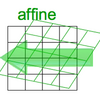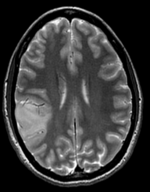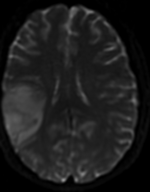Difference between revisions of "Projects:RegistrationLibrary:RegLib C29"
From NAMIC Wiki
(Created page with 'Back to ARRA main page <br> Back to Registration main page <br> [[Projects:RegistrationDocumentation:UseCaseInv…') |
|||
| Line 6: | Line 6: | ||
=== Input === | === Input === | ||
{| style="color:#bbbbbb; " cellpadding="10" cellspacing="0" border="0" | {| style="color:#bbbbbb; " cellpadding="10" cellspacing="0" border="0" | ||
| − | |[[Image: | + | |[[Image:RegLib_C29_thumb1.png|150px|lleft|this is the fixed reference image. All images are aligned into this space]] |
|[[Image:RegArrow_Affine.png|100px|lleft]] | |[[Image:RegArrow_Affine.png|100px|lleft]] | ||
| − | |[[Image: | + | |[[Image:RegLib_C29_thumb2.png|150px|lleft|this is the T2 reference image, serves as target to the DTI baseline, but is itself aligned to the SPGR]] |
| + | |[[Image:RegArrow_NonRigid.png|100px|lleft]] | ||
| + | |[[Image:RegLib_C29_thumb3.png|150px|lleft|this is the DTI Baseline scan, to be registered with the T2]] | ||
| + | |[[Image:RegLib_C29_thumb4.png|150px|lleft|this is the DTI tensor image, in the same orientation as the DTI Baseline]] | ||
|- | |- | ||
|fixed image/target | |fixed image/target | ||
| | | | ||
| − | |moving image | + | |moving image 1 |
| − | | | + | | |
| − | | | + | |moving image 2a |
| − | | | + | |moving image 2b |
| − | |||
| − | |||
| − | |||
| − | |||
| − | |||
|} | |} | ||
| Line 27: | Line 25: | ||
===Objective / Background === | ===Objective / Background === | ||
| − | This | + | This is a classic case of a multi-sequence MRI exam we wish to spatially align to the anatomical reference scan (T1-SPGR). The scan of interest is the DTI image to be aligned for surgical planning/reference. |
=== Keywords === | === Keywords === | ||
| − | MRI, brain, head, intra-subject, | + | MRI, brain, head, intra-subject, DTI, T1, T2, non-rigid, tumor, surgical planning |
===Input Data=== | ===Input Data=== | ||
| − | *reference/fixed : T1 SPGR , | + | *reference/fixed : T1 SPGR , 0.5x0.5x1 mm voxel size, 512 x 512 x 176 |
| − | *moving: T2 | + | *moving 1: T2 0.5x0.5x1.5 mm voxel size, 512 x 512 x 92 |
| − | * | + | *moving 2: DTI baseline: 1 x 1 x 3 mm, 256 x 256 x 41 |
| + | *moving 2b: 1 x 1 x 3 mm, 256 x 256 x 41 x 9 (tensor), original: DWI 256 x 256 x 41 x 32 directions | ||
===Registration Challenges=== | ===Registration Challenges=== | ||
| − | * | + | *The DTI sequence (EPI) contains string distortions we seek to correct via non-rigid alignment |
| − | * | + | *the DTI baseline is similar in contrast to a T2, albeit at much lower resolution |
| − | + | *we have different amounts of voxel-anisotropy | |
| − | *we | ||
| − | |||
| − | |||
| − | |||
===Key Strategies=== | ===Key Strategies=== | ||
| − | *'''Slicer 3.6 recommended modules: [http://www.slicer.org/slicerWiki/index.php/Modules:BRAINSFit BrainsFit], [http://www.slicer.org/slicerWiki/index.php/Modules:RegisterImagesMultiRes-Documentation-3.6 Robust Multiresolution Affine]''' | + | *'''Slicer 3.6.1 recommended modules: [http://www.slicer.org/slicerWiki/index.php/Modules:BRAINSFit BrainsFit], [http://www.slicer.org/slicerWiki/index.php/Modules:RegisterImagesMultiRes-Documentation-3.6 Robust Multiresolution Affine]''' |
| − | *we use an affine transform with 12 DOF (rather than a rigid one) to address distortion differences between the two protocols | + | *we use an 2-step approach: 1) we first co-register the T2 with the SPGR T1. 2) we register the DTI baseline to the T2 (the T1 provides insufficient similarity), 3) combine this with the Affine1 transform obtained from registering the T2 to the T1. affine transform with 12 DOF (rather than a rigid one) to address distortion differences between the two protocols; 4) resample the DTI volume with the new transform |
| − | + | ||
| − | |||
| − | |||
=== Procedures === | === Procedures === | ||
| Line 83: | Line 76: | ||
=== Registration Results=== | === Registration Results=== | ||
[[Image:RegLib_C02_Unreg_AnimGif.gif|500px|Unregistered Data + segmentation labelmap]] unregistered <br> | [[Image:RegLib_C02_Unreg_AnimGif.gif|500px|Unregistered Data + segmentation labelmap]] unregistered <br> | ||
| − | |||
| − | |||
<br> | <br> | ||
| − | '''Conclusion:''' | + | '''Conclusion:''' BrainsFit provides good registration but requires intermediate step of registering to T2. |
=== Download === | === Download === | ||
| − | *DATA:[[Media: | + | *DATA:[[Media:RegLib_C29_DATA.zip|'''Registration Library Case 29 (MRI) '' <small> (Data & Solution Xforms, zip file 18 MB) </small>]] |
| − | *PRESETS: | + | *PRESETS: |
*TUTORIALS: | *TUTORIALS: | ||
**[[Media:RegLib_C02_ScreenCast.mov| Screencast movie (Quicktime, 16MB)]] | **[[Media:RegLib_C02_ScreenCast.mov| Screencast movie (Quicktime, 16MB)]] | ||
Revision as of 16:14, 30 August 2010
Home < Projects:RegistrationLibrary:RegLib C29Back to ARRA main page
Back to Registration main page
Back to Registration Use-case Inventory
Contents
v3.6.1  Slicer Registration Library Case #29: Intra-subject Brain DTI
Slicer Registration Library Case #29: Intra-subject Brain DTI
Input

|

|

|

|

|

|
| fixed image/target | moving image 1 | moving image 2a | moving image 2b |
Modules
- Slicer 3.6.1 recommended modules: BrainsFit, Robust Multiresolution Affine
Objective / Background
This is a classic case of a multi-sequence MRI exam we wish to spatially align to the anatomical reference scan (T1-SPGR). The scan of interest is the DTI image to be aligned for surgical planning/reference.
Keywords
MRI, brain, head, intra-subject, DTI, T1, T2, non-rigid, tumor, surgical planning
Input Data
- reference/fixed : T1 SPGR , 0.5x0.5x1 mm voxel size, 512 x 512 x 176
- moving 1: T2 0.5x0.5x1.5 mm voxel size, 512 x 512 x 92
- moving 2: DTI baseline: 1 x 1 x 3 mm, 256 x 256 x 41
- moving 2b: 1 x 1 x 3 mm, 256 x 256 x 41 x 9 (tensor), original: DWI 256 x 256 x 41 x 32 directions
Registration Challenges
- The DTI sequence (EPI) contains string distortions we seek to correct via non-rigid alignment
- the DTI baseline is similar in contrast to a T2, albeit at much lower resolution
- we have different amounts of voxel-anisotropy
Key Strategies
- Slicer 3.6.1 recommended modules: BrainsFit, Robust Multiresolution Affine
- we use an 2-step approach: 1) we first co-register the T2 with the SPGR T1. 2) we register the DTI baseline to the T2 (the T1 provides insufficient similarity), 3) combine this with the Affine1 transform obtained from registering the T2 to the T1. affine transform with 12 DOF (rather than a rigid one) to address distortion differences between the two protocols; 4) resample the DTI volume with the new transform
Procedures
with BrainsFit (ca. 3 min):
- download example dataset
- load into 3DSlicer 3.6
- open Registration : BrainsFit module
- Input Parameters: set SPGR as fixed and FLAIR as moving image
- Registration Phases:
- select Initialize with CenterofHeadAlign
- select Include Rigid registration phase
- select "Include Affine registration phase"
- Output Settings: select "New Linear Transform" under Output Transform
- accept all other defaults & click apply
- program will automatically move FLAIR image under the result transform; also manually move the labelmap
- right click on either image and select Harden Transform to apply & resample
- save result images/scene
with MultiresolutionAffine (ca. 15 min):
- download example dataset
- load into 3DSlicer 3.6
- open Registration : RobustAffineMultiresolution module
- set SPGR as fixed and FLAIR as moving image
- accept all defaults & click apply
- go to Data module and move FLAIR and labelmap under the result transform
- right click on either image and select Harden Transform to apply & resample
- save result images/scene
for more details see the tutorial under Downloads
Registration Results
 unregistered
unregistered
Conclusion: BrainsFit provides good registration but requires intermediate step of registering to T2.